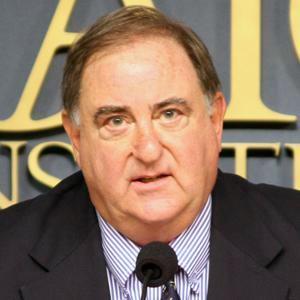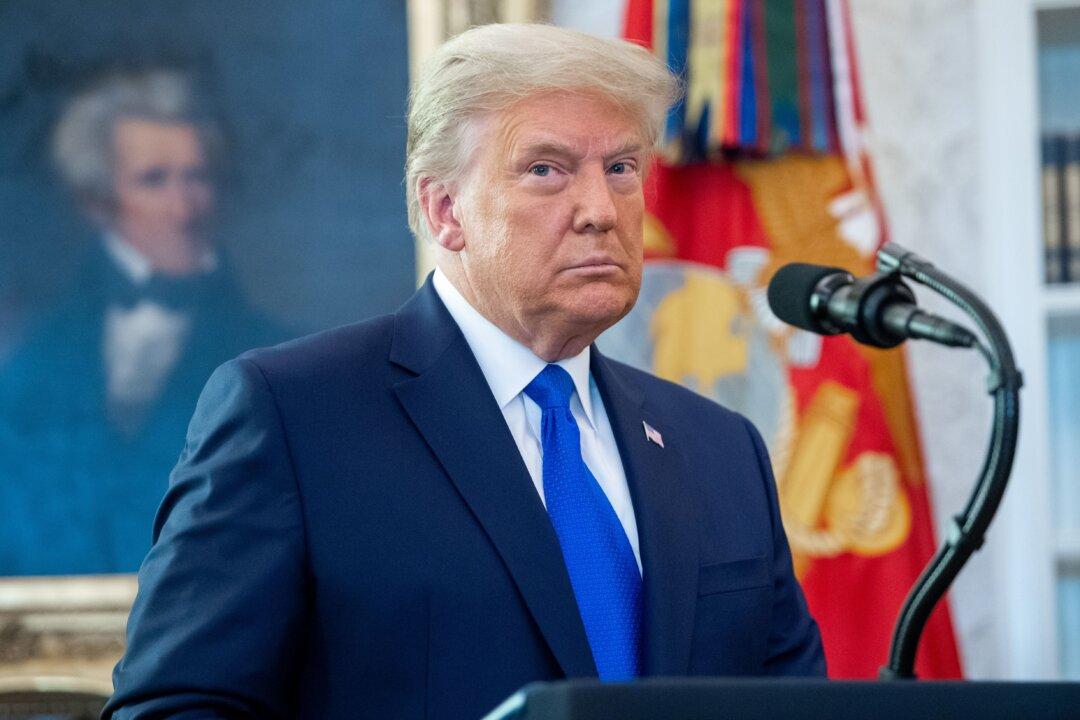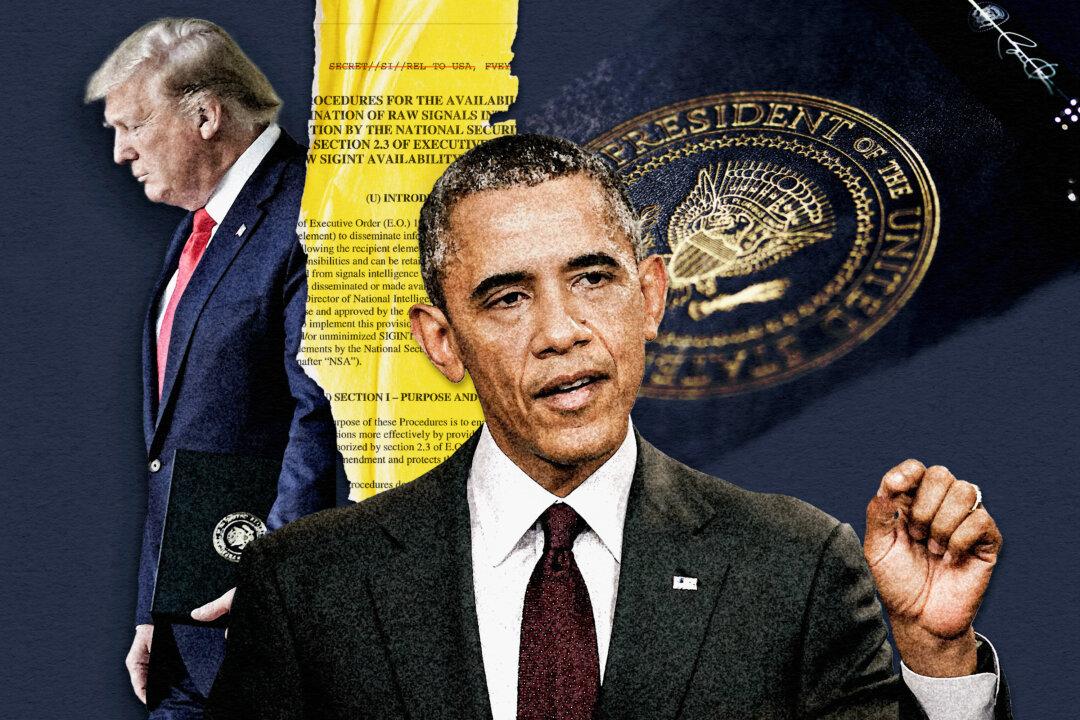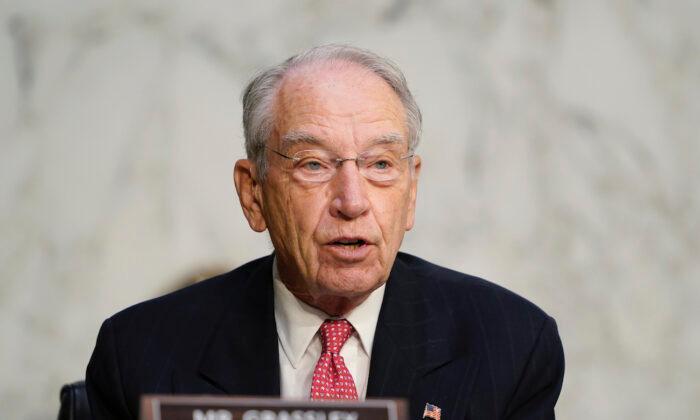Although the details remain complex, the structure underlying Spygate—the creation of the false narrative that candidate Donald Trump colluded with Russia, and the spying on his presidential campaign—remains surprisingly simple:
1. CIA Director John Brennan, with some assistance from Director of National Intelligence James Clapper, gathered foreign intelligence and fed it throughout our domestic Intelligence Community.
2. The FBI became the handler of Brennan’s intelligence and engaged in the more practical elements of surveillance.
3. The Department of Justice facilitated investigations by the FBI and legal maneuverings while providing a crucial shield of nondisclosure.
4. The Department of State became a mechanism of information dissemination and leaks.
5. Hillary Clinton’s presidential campaign and the Democratic National Committee provided funding, support, and media collusion.
6. Obama administration officials were complicit, and engaged in unmasking and intelligence gathering and dissemination.
7. The media was the most corrosive element in many respects. None of these events could have transpired without their willing participation. Stories were pushed, facts were ignored, and narratives were promoted.
Let’s start with a simple premise: The candidacy of Trump presented both an opportunity and a threat.
Initially not viewed with any real seriousness, Trump’s campaign was seen as an opportunistic wedge in the election process. At the same time, and particularly as the viability of his candidacy increased, Trump was seen as an existential threat to the established political system.
The sudden legitimacy of Trump’s candidacy was not welcomed by the U.S. political establishment. Here was a true political outsider who held no traditional allegiances. He was brash and boastful, he ignored political correctness, he couldn’t be bought, and he didn’t care what others thought of him—he trusted himself.
Governing bodies in Britain and the European Union were also worried. Candidate Trump was openly challenging monetary policy, regulations, and the power of special interests. He challenged Congress. He challenged the United Nations and the European Union. He questioned everything.

One method used to help establish evidence of collusion was the employment of “spy traps.” Prominent among these were ones set for Trump campaign advisers George Papadopoulos and Carter Page. The intent was to provide or establish connections between the Trump campaign and Russia. The content and context mattered little as long as a connection could be established that could then be publicized. The June 2016 Trump Tower meeting was another such attempt.
Western intelligence assets were used to initiate and establish these connections, particularly in the cases of Papadopoulos and Page.
Brennan’s inter-agency task force is not to be confused with the July 2016 FBI counterintelligence investigation, which was formed later at Brennan’s urging.
“I have seen intelligence reports that clearly show the president-elect and his team were monitored and disseminated out in intelligence-reporting channels. Details about persons associated with the incoming administration, details with little apparent foreign-intelligence value were widely disseminated in intelligence community reporting.
“I made sure that anything that was involving U.S. persons, including anything involving the individuals involved in the Trump campaign, was shared with the [FBI].”Brennan also admitted that his intelligence helped establish the FBI investigation:
“I was aware of intelligence and information about contacts between Russian officials and U.S. persons that raised concerns in my mind about whether or not those individuals were cooperating with the Russians, either in a witting or unwitting fashion, and it served as the basis for the FBI investigation to determine whether such collusion [or] cooperation occurred.”
This admission is important, as no official intelligence was used to open the FBI’s investigation.This final report was used to continue pushing the Russia-collusion narrative following the election of President Donald Trump. Notably, Admiral Mike Rogers of the NSA publicly dissented from the findings of the ICA, assigning only a moderate confidence level.

Federal Bureau of Investigation
Although the FBI is technically part of the DOJ, it is best for the purposes of this article that the FBI and DOJ be viewed as separate entities, each with its own related ties.The FBI itself was comprised of various factions, with a particularly active element that has come to be known as the “insurance policy group.” It appears that this faction was led by FBI Deputy Director Andrew McCabe and comprised other notable names such as FBI agent Peter Strzok, FBI lawyer Lisa Page, and FBI general counsel James Baker.
Comey also testified that he did not provide notification to the Gang of Eight until early March 2017—less than one month earlier. This admission was in stark contrast to actions taken by Brennan, who had notified members of the Gang of Eight individually during August and September 2016. It’s likely that Brennan never informed Comey that he had briefed the Gang of Eight in 2016. Comey did note that the DOJ “had been aware” of the investigation all along.

Following Comey’s firing on May 9, 2017, the FBI’s investigation was transferred to special counsel Robert Mueller. The Mueller investigation remains ongoing.
It’s worth noting that there was no “dossier” until it was fully compiled in December 2016. There was only a sequence of documents from Steele—documents that were passed on individually—as they were created. Therefore, from the FBI’s legal perspective, they didn’t use the dossier. They used individual documents.
Page was now the FBI’s chosen target for a FISA warrant that would be obtained on Oct. 21, 2016. The Steele dossier would be the primary evidence used in obtaining the FISA warrant, which would be renewed three separate times, including after Trump took office, finally expiring in September 2017.

Peter Strzok and Lisa Page
Peter Strzok and Lisa Page were two prominent members of the FBI’s “insurance policy” group. Strzok, a senior FBI agent, was the deputy assistant director of FBI’s Counterintelligence Division. Lisa Page, an FBI lawyer, served as special counsel to FBI Deputy Director Andrew McCabe.Strzok was in charge of the investigation into Hillary Clinton’s use of a private email server for government business. He helped FBI Director James Comey draft the statement exonerating Clinton and was personally responsible for changing specific wording within that statement that reduced Clinton’s legal liability. Specifically, Strzok changed the words “grossly negligent,” which could be a criminal offense, to “extremely careless.”
Strzok also personally led the FBI’s counterintelligence investigation into the alleged Trump–Russia collusion and signed the documents that opened the investigation on July 31, 2016. He was one of the FBI agents who interviewed Trump’s national security adviser, Gen. Michael Flynn. Strzok met multiple times with DOJ official Bruce Ohr and received information from Steele at those meetings.
Following the firing of FBI Director James Comey, Strzok would join the team of special counsel Robert Mueller. Two months later, he was removed from that team after the DOJ inspector general discovered a lengthy series of texts between Strzok and Page that contained politically charged messages. Strzok would be fired from the FBI in August 2018.

Page: ”[Trump is] not ever going to become president, right? Right?!”
“I want to believe the path you threw out for consideration in Andy’s office—that there’s no way [Trump] gets elected—but I’m afraid we can’t take that risk. ... It’s like an insurance policy in the unlikely event you die before you’re 40.”The “insurance policy” appears to have been the effort to legitimize the Trump–Russia collusion narrative so that an FBI investigation, led by McCabe, could continue unhindered.
Department of Justice
The Department of Justice, which comprises 60 agencies, was transformed during the Obama years. The department is forbidden by federal law from hiring employees based on political affiliation.The DOJ’s job in Spygate was to facilitate the legal side of surveillance while providing a protective layer of cover for all those involved. The department became a repository of information and provided a protective wall between the investigative efforts of the FBI and the legislative branch. Importantly, it also served as the firewall within the executive branch, serving as the insulating barrier between the FBI and Obama officials. The department had become legendary for its stonewalling tactics with Congress.

According to testimony from FBI agent Peter Strzok, he and Ohr met at least five times during 2016 and 2017. Strzok was working directly with then-Deputy FBI Director Andrew McCabe.
The Battle Between Rosenstein and McCabe
Deputy FBI Director Andrew McCabe held a pivotal role in what has become known as “Spygate.” He directed the activities of Peter Strzok and Lisa Page and was involved in all aspects of the Russia investigation. He was also mentioned in the infamous “insurance policy” text message.McCabe was a major component of the insurance policy.
On April 26, 2017, Rosenstein found himself appointed as the new deputy attorney general. He was placed into a somewhat chaotic situation, as Attorney General Jeff Sessions had recused himself from the ongoing Russia investigation a little less than two months earlier, on March 2, 2017. This effectively meant that no one in the Trump administration had any oversight of the ongoing investigation being conducted by the FBI and the DOJ.
Additionally, the leadership of then-FBI Director James Comey was coming under increased scrutiny as the result of actions taken leading up to and following the election, particularly Comey’s handling of the Clinton email investigation.
On May 9, 2017, Rosenstein wrote a memorandum recommending that Comey be fired. The subject of the memo was “Restoring Public Confidence in the FBI.” Comey was fired that day.
McCabe was now the acting director of the FBI and was immediately under consideration for the permanent position.
On the same day Comey was fired, McCabe would lie during an interview with agents from the FBI’s Inspection Division (INSD) regarding apparent leaks that were used in an Oct. 30, 2016, Wall Street Journal article, “FBI in Internal Feud Over Hillary Clinton Probe” by Devlin Barrett. This would later be disclosed in the inspector general report, “A Report of Investigation of Certain Allegations Relating to Former Deputy FBI Director Andrew McCabe.”
At the time, nobody, including the INSD agents, knew that McCabe had lied, nor were the darker aspects of McCabe’s role in Spygate fully known.
In late April or early May 2016, McCabe opened a federal criminal investigation on Sessions, regarding potential lack of candor before Congress in relation to Sessions’s contacts with Russians. Sessions was unaware of the investigation.
Sessions would later be cleared of any wrongdoing by special counsel Robert Mueller.
On the morning of May 16, 2017, Rosenstein reportedly suggested to McCabe that he secretly record President Trump. This remark was reported in a New York Times article that was sourced from memos from the now-fired McCabe, along with testimony taken from former FBI general counsel James Baker, who relayed a conversation he had with McCabe about the occurrence. Rosenstein issued a statement denying the accusations.
The alleged comments by Rosenstein occurred at a meeting where McCabe was “pushing for the Justice Department to open an investigation into the president.”
An unnamed participant at the meeting, in comments to The Washington Post, framed the conversation somewhat differently, noting Rosenstein responded sarcastically to McCabe, saying, “What do you want to do, Andy, wire the president?”
Later, on the same day that Rosenstein had his meetings with McCabe, President Trump met with Mueller, reportedly as an interview for the FBI director job.
On May 17, 2017, the day after President Trump’s meeting with Mueller—and the day after Rosenstein’s encounters with McCabe—Rosenstein appointed Mueller as special counsel.
The May 17 appointment of Mueller in effect shifted control of the Russia investigation from the FBI and McCabe to Mueller. Rosenstein would retain ultimate authority for the probe and any expansion of Mueller’s investigation required authorization from Rosenstein.
Interestingly, without Comey’s memo leaks, a special counsel might not have been appointed—the FBI, and possibly McCabe, would have remained in charge of the Russia investigation. McCabe was probably not going to become the permanent FBI director, but he was reportedly under consideration. Regardless, without Comey’s leak, McCabe would have retained direct involvement and the FBI would have retained control.
On July 28, 2017, McCabe lied to Inspector General Michael Horowitz while under oath regarding authorization of the leaking to The Wall Street Journal. At this point, Horowitz knew McCabe was lying, but did not yet know of the May 9 INSD interview with McCabe.
On Aug. 2, 2017, Rosenstein secretly issued Mueller a revised memo on “the scope of investigation and definition of authority” that remains heavily redacted. The full purpose of this memo remains unknown. On this same day, Christopher Wray was named as the new FBI director.
That Aug. 2 memo from Rosenstein to Mueller may have been specifically designed to remove any residual FBI influence—specifically that of McCabe—from the Russia investigation. The appointment of Wray as FBI director helped cement this. McCabe was finally completely neutralized.
State Department
The State Department, with its many contacts within foreign governments, became a conduit for the flow of information. The transfer of Christopher Steele’s first dossier memo was personally facilitated by Victoria Nuland, the assistant secretary of state for European and Eurasian affairs. Nuland gave approval for FBI agent Michael Gaeta to travel to London to obtain the memo from Steele. The memo may have passed directly from her to FBI leadership. Secretary of State John Kerry was also given a copy.
“In the middle of July, when [Steele] was doing this other work and became concerned, he passed two to four pages of short points of what he was finding and our immediate reaction to that was, this is not in our purview. This needs to go to the FBI if there is any concern here that one candidate or the election as a whole might be influenced by the Russian Federation. That’s something for the FBI to investigate.”Steele also met with Jonathan Winer, a former deputy assistant secretary of state for international law enforcement and former special envoy for Libya. Steele and Winer had known each other since at least 2010. In an opinion article in The Washington Post, Winer wrote the following:
“In September 2016, Steele and I met in Washington and discussed the information now known as the ‘dossier.’ Steele’s sources suggested that the Kremlin not only had been behind the hacking of the Democratic National Committee and the Hillary Clinton campaign but also had compromised Trump and developed ties with his associates and campaign.”In a strange turn of events, Winer also received a separate dossier, very similar to Steele’s, from long-time Clinton confidant Sidney Blumenthal. This “second dossier” had been compiled by another longtime Clinton operative, former journalist Cody Shearer, and echoed claims made in the Steele dossier. Winer then met with Steele in late September 2016 and gave Steele a copy of the “second dossier.” Steele went on to share this second dossier with the FBI, which may have used it to corroborate his dossier.

If true, this would mean that neither Australian intelligence nor the Australian government alerted the FBI to the Papadopoulos information. What happened with the Downer details, and to whom they were ultimately relayed, remains unknown.
“A dossier of compromising information on Hillary Clinton has been collated by the Russian Intelligence Services over many years and mainly comprises bugged conversations she had on various visits to Russia and intercepted phone calls. ... It has not yet been distributed abroad, including to Trump.”
Clinton Campaign and the DNC
The Clinton campaign and the Democratic National Committee both occupied a unique position. They had the most to gain but they also had the most to lose. And they stood willing and ready to do whatever was necessary to win. Hillary Clinton’s campaign manager, Robby Mook, is credited with being the first to raise the specter of candidate Donald Trump’s alleged collusion with Russia.The entire Clinton campaign willfully promoted the narrative of Russia–Trump collusion despite the uncomfortable fact that they were the ones who had engaged the services of Fusion GPS and Christopher Steele through their law firm Perkins Coie. Information flowed from the campaign—sometimes through Perkins Coie, other times through affiliates—ultimately making its way into the media and sometimes to the FBI. Information from the Clinton campaign may also have ended up in the Steele dossier.

“Computer scientists have apparently uncovered a covert server linking the Trump Organization to a Russian-based bank.”Attached to her tweet was a statement from Sullivan:
“This could be the most direct link yet between Donald Trump and Moscow. Computer scientists have apparently uncovered a covert server linking the Trump Organization to a Russian-based bank.
This type of behavior would be engaged in repeatedly—damning leaks leading to media stories, followed by ready attacks from the Clinton campaign.
Perkins Coie
International law firm Perkins Coie served as the legal arm for both the Clinton campaign and the DNC. Ties to Perkins Coie extended beyond the DNC into the Obama White House.
Obama Administration
The Obama administration provided a simultaneous layer of protection and facilitation for the entire effort. One example is provided by Section 2.3 of Executive Order 12333, also known as Obama’s data-sharing order. With the passage of the order, agencies and individuals were able to ask the NSA for access to specific surveillance simply by claiming the intercepts contained relevant information that was useful to a particular mission.Section 2.3 had been expected to be finalized by early to mid-2016. Instead, Director of National Intelligence James Clapper didn’t sign off on Section 2.3 until Dec. 15, 2016. The order was finalized when Attorney General Loretta Lynch signed it on Jan. 3, 2017.
The reason for the delay could relate to the fact that while the executive order made it easier to share intelligence between agencies, it also limited certain types of information from going to the White House.
“I was urging my former colleagues and, frankly speaking, the people on the Hill ... ‘Get as much information as you can. Get as much intelligence as you can before President Obama leaves the administration.’

Many of the Obama administration’s efforts appear to have been structural in nature, such as establishing new procedures or creating impediments to oversight that enabled much of the surveillance abuse to occur.
“We got access to information up to 2010 in all of these categories. No law changed in 2010. No policy changed. ... It was simply a decision by the General Counsel’s Office in 2010 that they viewed, now, the law differently. And as a result, they weren’t going to give us that information.”These new restrictions were put in place by Attorney General Eric Holder and Deputy Attorney General James Cole.
The following day, Brennan, Clapper, and Comey attached a written summary of the Steele dossier to the classified briefing they gave Obama. Comey then met with President-elect Trump to inform him of the dossier. This meeting took place just hours after Comey, Brennan, and Clapper formally briefed Obama on both the Intelligence Community assessment and the Steele dossier.
“Because that was the part that the leaders of the Intelligence Community agreed he needed to be told about.”Shortly after Comey’s meeting with Trump, both the Trump–Comey meeting and the existence of the dossier were leaked to CNN. The significance of the meeting was material, as Comey noted in a Jan. 7 memo he wrote:
“Media like CNN had them and were looking for a news hook. I said it was important that we not give them the excuse to write that the FBI has the material.”

Executive Order 13762
President Barack Obama issued a last-minute executive order on Jan. 13, 2017, that altered the line of succession within the DOJ. The action was not done in consultation with the incoming Trump administration.Acting Attorney General Sally Yates was fired on Jan. 30, 2017, by a newly inaugurated President Trump for refusing to uphold the president’s executive order limiting travel from certain terror-prone countries. Yates was initially supposed to serve in her position until Jeff Sessions was confirmed as attorney general.
Obama’s executive order placed the U.S. attorney for the District of Columbia next in line behind the department’s senior leadership. The attorney at the time was Channing Phillips.
Phillips was first hired by former Attorney General Eric Holder in 1994 for a position in the D.C. U.S. attorney’s office. Phillips, after serving as a senior adviser to Holder, stayed on after he was replaced by Attorney General Loretta Lynch.
It appears the Obama administration was hoping the Russia investigation would default to Channing in the event Sessions was forced to recuse himself from the investigation. Sessions, whose confirmation hearings began three days before the order, was already coming under intense scrutiny.
The implementation of the order may also tie into Yates’s efforts to remove Gen. Michael Flynn over his call with the Russian ambassador.
Trump ignored the succession order, as he is legally allowed to do, and instead appointed Dana Boente, the U.S. attorney for the Eastern District of Virginia, as acting attorney general on Jan. 30, 2017, the same day Yates was fired.
Trump issued a new executive order on Feb. 9, 2017, the same day Sessions was sworn in, reversing Obama’s prior order.
Media
In some respects, the media has played the most disingenuous of roles. Areas of investigation that historically would have proven irresistible to reporters of the past have been steadfastly ignored. False narratives have been all-too-willingly promoted and facts ignored. Fusion GPS personally made a series of payments to several as-of-yet-unnamed reporters.The majority of the mainstream media has represented positions of the DNC and the Clinton campaign.
Leaking, including felony leaking of classified information, has been widespread. The Carter Page FISA warrant—likely the unredacted version—has been in the possession of The Washington Post and The New York Times since March 2017. Traditionally, the intelligence community leaked to The Washington Post while the DOJ leaked to sources within The New York Times. This was a historical pattern that stood until this election. The leaking became so widespread, even this tradition was broken.

It appears probable that Wolfe leaked unredacted copies of the Page FISA application.
The original Page FISA application is 83 pages long, including one final signatory page.
In the public version of the application, there are 37 fully redacted pages. In addition to that, several other pages have redactions for all but the header. There are only two pages in the entire document that contain no redactions.
Why would Wolfe bother to send 37 pages of complete redactions? It seems more than plausible that Wolfe took pictures of the original unredacted FISA application and sent them by text to Watkins.
Foreign Intelligence
UK and Australian intelligence agencies also played meaningful roles during the 2016 presidential election.
As GCHQ was gathering intelligence, low-level Trump campaign foreign-policy adviser George Papadopoulos appears to have been targeted after a series of highly coincidental meetings. Maltese professor Josef Mifsud, Australian diplomat Alexander Downer, FBI informant Stefan Halper, and officials from the UK’s Foreign and Commonwealth Office (FCO) all crossed paths with Papadopoulos—some repeatedly so.
Christopher Steele, who authored the dossier on Trump, was an MI6 agent while the agency was headed by Sir Richard Dearlove. Steele retains close ties with Dearlove.
Trump, after issuing an order for the declassification of documents and text messages related to the Russia-collusion investigations—including parts of the Carter Page FISA warrant application—received phone calls from two U.S. allies saying, “Please, can we talk.” Those “allies” were almost certainly the UK and Australia.
Questions to be asked are why is it that two of our allies would find themselves so opposed to the release of these classified documents that a coordinated plea would be made directly to the president? And why would these same allies have even the slightest idea of what was contained in these classified U.S. documents?
Fusion GPS/Orbis/Christopher Steele
Glenn Simpson, a former Wall Street Journal reporter, is co-founder of Fusion GPS, along with Peter Fritsch and Tom Catan. Fusion was hired by the DNC and the Clinton campaign through law firm Perkins Coie to produce and disseminate the Steele dossier used against Trump. The dossier would later be the primary evidence used to obtain a FISA warrant on Carter Page on Oct. 21, 2016.
“Hi. Steele: would like to get a bi partisan letter from the committee; Assange: I convinced him to make serious and important concessions and am discussing those w DOJ; Deripaska: willing to testify to congress but interested in state of play w Manafort. I will be with him next tuesday for a week.”Steele also appears to have lobbied on behalf of Deripaska, who was discussed in emails between Bruce Ohr and Steele that were recently disclosed by the Washington Examiner:
“Steele said he was ‘circulating some recent sensitive Orbis reporting’ on Deripaska that suggested Deripaska was not a ’tool' of the Kremlin. Steele said he would send the reporting to a name that is redacted in the email.”Fusion GPS was also employed by Russian lawyer Natalia Veselnitskaya in a previous case. Veselnitskaya was involved in litigation pitting Russian firm Prevezon Holdings against British-American financier William Browder. Veselnitskaya hired U.S. law firm BakerHostetler, who, in turn, hired Fusion GPS to dig up dirt on Browder. Veselnitskaya was one of the participants at the June 2016 Trump Tower meeting, at which she discussed the Magnitsky Act.
A declassified top-secret Foreign Intelligence Surveillance Court report released on April 26, 2017, revealed that government agencies, including the FBI, CIA, and NSA, had improperly accessed Americans’ communications. The FBI specifically provided outside contractors with access to raw surveillance data on American citizens without proper oversight.
Communications and other data of members of the Trump campaign may have been accessed in this way.

Nellie Ohr, the wife of high-ranking DOJ official Bruce Ohr, was hired by Fusion GPS to work on the dossier on Trump.
Spy Traps
In an effort to put forth evidence of collusion between the Trump campaign and Russia, it appears that several different spy traps were set, with varying degrees of success. Many of these efforts appear to center around Trump campaign adviser George Papadopoulos and involve London-based professor Joseph Mifsud, who has ties to Western intelligence, particularly in the UK.Mifsud introduced Papadopoulos to several Russians, including Olga Polonskaya, whom Mifsud introduced as “Putin’s niece,” and Ivan Timofeev, an official at a state-sponsored think tank called the Russian International Affairs Council. Both Papadopoulos and Mifsud were interviewed by the FBI. Papadopoulos was ultimately charged with a process crime and was recently sentenced to 14 days in prison for lying to the FBI. Mifsud was never charged by the FBI.
Throughout this period, Papadopoulos continuously pushed for meetings between Trump campaign officials and Russian contacts but was ultimately unsuccessful in establishing any meetings.
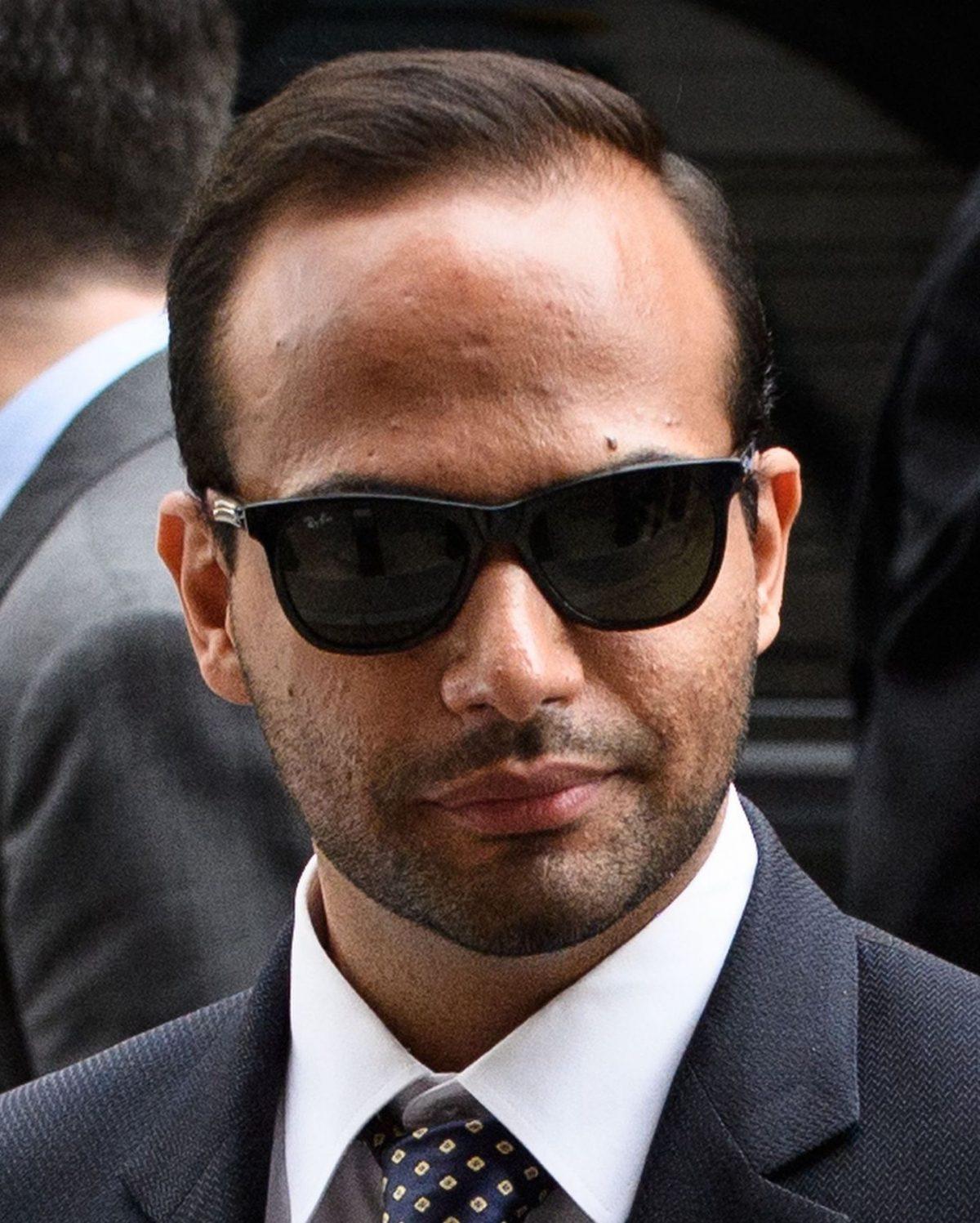
Interestingly, there is no mention of Papadopoulos in the Steele dossier. Paul Manafort, Carter Page, former Trump lawyer Michael Cohen, Gen. Michael Flynn, and former Trump campaign manager Corey Lewandowski are all listed in the Steele dossier.
Papadopoulos may have started out assisting the FBI or CIA and later discovered that he was being set up for surveillance himself.
After failing to obtain a spy warrant on the Trump campaign using Papadopoulos, the FBI set its sights on campaign volunteer Carter Page. By this time, the counterintelligence investigation was in the process of being established, and we know now that it was formalized with no official intelligence. The FBI needed some sort of legal cover. They needed a retroactive warrant. And they got one on Oct. 21, 2016. The Page FISA warrant would be renewed three times and remain in force until September 2017.
If the FBI failed to disclose Page’s cooperation with the bureau or materially misrepresented his involvement in its application to the FISA Court, it means that the FBI’s Woods procedures, which govern FISA applications, were violated.
FISA Abuse
Admiral Mike Rogers, while director of the NSA, was personally responsible for uncovering an unprecedented level of FISA abuse that would later be documented in a 99-page unsealed FISA court ruling. As the FISA court noted in the April 26, 2017, ruling, the abuses had been occurring since at least November 2015:“The FBI had disclosed raw FISA information, including but not limited to Section 702-acquired information, ... to private contractors.
“Private contractors had access to raw FISA information on FBI storage systems.
“The Court is concerned about the FBI’s apparent disregard of minimization rules and whether the FBI may be engaging in similar disclosures of raw Section 702 information that have not been reported.”The FISA Court disclosed that illegal NSA database searches were endemic. Private contractors, employed by the FBI, were given full access to the NSA database. Once in the contractors’ possession, the data couldn’t be traced.
On April 18, 2016, Rogers shut down all outside contractor access to raw FISA information—specifically outside contractors working for the FBI.

On Oct. 21, 2016, the DOJ and the FBI sought and received a Title I FISA probable-cause order authorizing electronic surveillance on Carter Page from the FISA Court.
At this point, the FISA Court was still unaware of the Section 702 violations.
The FISA Court had been unaware of the query violations until they were presented to the court by Rogers.
Carlin didn’t disclose his knowledge of FISA abuse in the annual Section 702 certifications in order to avoid raising suspicions at the FISA Court ahead of receiving the Page FISA warrant.
The FBI and the NSD were literally racing against Rogers’s investigation in order to obtain a FISA warrant on Carter Page.
The Insurance Policy
Ever since the release of FBI text messages revealing the existence of an “insurance policy,” the term has been the subject of wide speculation.Some observers have suggested that the insurance policy was the FISA spy warrant used to monitor Trump campaign adviser Carter Page and, by extension, other members of the Trump campaign. This interpretation is too narrow and fails to capture the underlying meaning of the text.
The insurance policy was the actual process of establishing the Trump–Russia collusion narrative.
It encompassed actions undertaken in late 2016 and early 2017, including the leaking of the Steele dossier and James Clapper’s leaks of James Comey’s briefing to President Trump. The intent behind these actions was simple. The legitimization of the investigation into the Trump campaign.
The strategy involved the recusal of Trump officials with the intent that Andrew McCabe would end up running the investigation.
The Steele dossier, which was paid for by the Clinton presidential campaign and the Democratic National Committee, served as the foundation for the Russia narrative.
The intelligence community, led by CIA Director John Brennan and DNI James Clapper, used the dossier as a launching pad for creating their Intelligence Community assessment.
This report, which was presented to Obama in December 2016, despite NSA Director Mike Rogers having only moderate confidence in its assessment, became one of the core pieces of the narrative that Russia interfered with the 2016 elections.
Spygate
Spygate represents the biggest political scandal in our nation’s history. A sitting administration actively colluded with a political campaign to affect the outcome of a U.S. presidential election. Government agencies were weaponized and a complicit media spread intelligence community leaks as facts.But a larger question remains: How long has the United States been subject to interference from the intelligence community and our political agencies? Was the 2016 presidential election a one-time aberration, or is this episode symptomatic of a larger pattern extending back decades?
The intensity, scale, and coordination suggest something greater than overzealous actions taken during a single election. They represent a unified reaction of the establishment to a threat posed by a true outsider—a reaction that has come to be known as Spygate.




